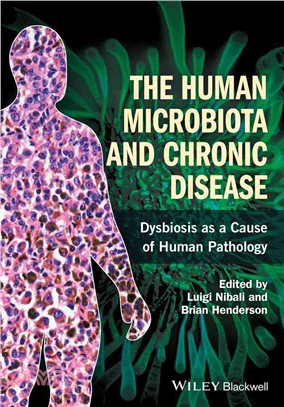The Human Microbiota And Chronic Disease: Dysbiosis As A Cause Of Human Pathology
商品資訊
ISBN13:9781118982877
出版社:John Wiley & Sons Inc
作者:Henderson
出版日:2016/08/08
裝訂/頁數:精裝/544頁
規格:24.8cm*17.8cm*3.2cm (高/寬/厚)
商品簡介
The human organism comprises 1013 eukaryotic cells, divided into a large number of distinct organs and tissues, with unimaginable requirements for inter- and intra-cellular communication. Malfunction in such communication inevitably results in the state we define as human disease. The emergent properties of the eukaryotic cellular complexity in Homo sapiens were beginning to be suspected in the 1950s and 1960s, at a time when it was becoming clear that the bacteria that actually existed within the healthy human could have a major influence on many of its cellular and tissue systems, including innate and adaptive immunity. The development of antibiotic resistance in the 1970s, produced a renaissance in Microbiology which revealed just how heavily colonised healthy vertebrates were with bacteria. The human appears to be the acme of this colonisation process and it is now a familiar expression that ‘for every human cell in our bodies there are ten bacteria’. Not only are we colonised by around 1014 bacteria, the human population carries round with it a diversity of bacterial phylotypes that swamps the diversity of all the species in the aggregate of the World’s zoological collections. Thus we can no longer think of bacteria in terms of ‘us’ and ‘them’. Homo sapiens, like most vertebrates, has to be viewed as a supra organism colonised, on its mucosal surfaces and on the skin (and who knows where else), with complex populations of bacteria, with each individual having a unique mixture of these bacteria, presumably a result of genetic (and/or epigenetic) factors controlling commensal bacterial colonisation and the stability of such colonisation.
Not only are we colonised by a large and diverse collection of bacteria (this volume will ignore colonisation by single celled eukaryotes and by Archaea), these bacteria are generally in the form of dynamic multi-species biofilms which, like the comparison of human tissues to the disaggregated cells of these tissues, have emergent properties. Thus the collection of microbes in our bodies, which we call the microbiota, is a dynamically complex collection of multi-species biofilms. The formation of these biofilms will require an inordinate amount of intercellular signalling and this signalling must reciprocate with the cellular surfaces on which these biofilms co-exist. These cellular surfaces are ‘us’.
In the 21st Century, the concept of human health and disease has to take into account the intimate relationship that we must have with our microbiota. The regional complexity of the human microbiota is only now emerging with the application of bacterial phylogenetic analyses through the use of next generation sequencing (NGS) methodologies. This overcomes the problem that only around 50% of the bacteria colonising the human can be cultivated and studied. Each of us is colonised with hundreds of bacterial phylotypes, with each phylotype itself being composed of a varied range of strains, each containing different populations of genes. This generates the concept of the pan-genome with each bacterial pan-genome perhaps having as many protein-coding genes as does its host. This means that the individual bacterial populations colonising each human has 10-100, or more, times the number of genes that is utilised by the host. Every human host is colonised by a different combination of microbes, making him/her more or less susceptible to disease. Host genetic variants are largely responsible for determining the composition of human microbial biofilms. This creates a level of complexity that is difficult to comprehend, and one that needs to be fully explored if we are to understand the healthy human and the diseases s/he is susceptible to.
However, the determination, starting in the 1980s, of how enormously colonised we are by bacteria, and the potential bacteria have for interfering with all aspects of our cellular homeostasis, has brought the bacterium, centre stage, as a causative factor in both maintaining human health and disease and even in playing a role in our ageing processes.
Microbiota-associated pathology can be as a direct result of changes in general bacterial composition, such as might be found in periodontitis and bacterial vaginosis, and/or as the result of colonisation and/or overgrowth of so called keystone species such as the oral organism Porphyromonas gingivalis or the gastrointestinal bacterium, Helicobacter hepaticus. This introduces the concept of dysbiosis, defined as a disruption in the composition of the normal microbiota.
This volume discusses the role of the microbiota in maintaining human health and introduces the reader to the biology of bacterial dysbiosis and its potential role in both bacterial disease and in idiopathic chronic disease states. The current book is divided into five chapters, starting from the concept of the human bacterial microbiota (chapter 1) with particular attention being paid to the microbiotae of the gut, oral cavity and skin. A key methodology for exploring the microbiota, metagenomics, is also described. The second section attempts to show the reader the cellular, molecular and genetic complexities of the bacterial microbiota, its myriad connections with the host and how these can maintain tissue homeostasis. Section 3 begins to consider the role of dysbioses in human disease states, dealing with two of the commonest bacterial diseases of humanity – periodontitis and bacterial vaginosis. The composition of some, if not all microbiotas can be controlled by the diet and this is also dealt with in this section. In section 4 the discussion moves onto the major ‘idiopathic’ diseases of Homo sapiens and the potential role that dysbiosis could play in their induction and chronicity. This is a rapidly growing area where major discoveries are expected. Section 5 takes the reader to the therapeutic potential of manipulating the microbiota, introducing the concepts of probiotics, prebiotics and the administration of healthy human faeces (faecal microbiota transplantation), and then gazes into the crystal ball and imagines the future of medical treatment viewed from a microbiota-centric position.
作者簡介
Brian Henderson is a Professor of Microbial Diseases in the School of Life and Medical Sciences at University College London in London, UK.
主題書展
更多書展今日66折
您曾經瀏覽過的商品
購物須知
外文書商品之書封,為出版社提供之樣本。實際出貨商品,以出版社所提供之現有版本為主。部份書籍,因出版社供應狀況特殊,匯率將依實際狀況做調整。
無庫存之商品,在您完成訂單程序之後,將以空運的方式為你下單調貨。為了縮短等待的時間,建議您將外文書與其他商品分開下單,以獲得最快的取貨速度,平均調貨時間為1~2個月。
為了保護您的權益,「三民網路書店」提供會員七日商品鑑賞期(收到商品為起始日)。
若要辦理退貨,請在商品鑑賞期內寄回,且商品必須是全新狀態與完整包裝(商品、附件、發票、隨貨贈品等)否則恕不接受退貨。
























